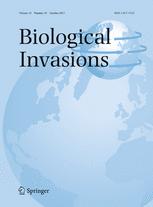Ver ítem
- xmlui.general.dspace_homeCentros Regionales y EEAsCentro Regional Patagonia NorteEEA BarilocheArtículos científicosxmlui.ArtifactBrowser.ItemViewer.trail
- Inicio
- Centros Regionales y EEAs
- Centro Regional Patagonia Norte
- EEA Bariloche
- Artículos científicos
- Ver ítem
Half a century of changes in the riverine landscape of Limay River: the origin of a riparian neoecosystem in Patagonia (Argentina)
Resumen
Our study aims to determine the dynamic that led to the spread of exotic Salicaceae on the Limay River floodplain and its implications in shaping the current neoecosystem. We used images obtained by the HRG sensor on board the SPOT-5 satellite. We selected two images dates allowed a comparison of the floodplain under different flooding regimes programmed by the Interjuridiccional Basin Authority, at a rate of 1290 m3/s in Spring and a flow rate of less
[ver mas...]
Our study aims to determine the dynamic that led to the spread of exotic Salicaceae on the Limay River floodplain and its implications in shaping the current neoecosystem. We used images obtained by the HRG sensor on board the SPOT-5 satellite. We selected two images dates allowed a comparison of the floodplain under different flooding regimes programmed by the Interjuridiccional Basin Authority, at a rate of 1290 m3/s in Spring and a flow rate of less than 400 m3/s in Summer. To characterize the vegetation cover, the Normalized Difference Vegetation Index (NDVI) was used to compare images of September and December, also the Normalized Difference Water Index (NDWI) was applied to delineate the riverbed and floodplain in September. To evaluate the influence of flooding regime on the detected patches a Principal Component Analysis (PCA), was performed; and biotic and abiotic factors on the composition of the dominant tree species in each patch by Multiple Factor Analysis (MFA) were analized. A 58.4 % coverage of forest patches had developed on the Limay River floodplain. Patches of older trees grew on surfaces at 1.5 m above the water level. However, the surfaces not reached by floods >1.5 m have a very low rocky coverage (1 %). The analysis of the age of the trees downstream of the dam system showed that the vegetation, often exposed to high floods before the dams were built (1971), was composed of the native willow (Salix humboldtiana) and the exotic Salix alba. As the river regime was attenuated and extraordinary floods disappeared with the operation of the dam Arroyito in 1980, the first patches of Populus nigra spread.
[Cerrar]

Autor
Datri, Leonardo Ariel;
Faggi, Ana Maria;
Gallo, Leonardo Ariel;
Carmona, Facundo;
Fuente
Biological Invasions 18 (6) : 1713–1722 (June 2016)
Fecha
2016-06
Editorial
Springer
ISSN
1387-3547
1573-1464
1573-1464
Formato
pdf
Tipo de documento
artículo
Palabras Claves
Derechos de acceso
Restringido
 Excepto donde se diga explicitamente, este item se publica bajo la siguiente descripción: Creative Commons Attribution-NonCommercial-ShareAlike 2.5 Unported (CC BY-NC-SA 2.5)
Excepto donde se diga explicitamente, este item se publica bajo la siguiente descripción: Creative Commons Attribution-NonCommercial-ShareAlike 2.5 Unported (CC BY-NC-SA 2.5)

